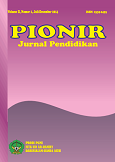THE POTENTIAL OF THE DISTAR LEARNING MODEL TO ENHANCE STUDENTS’ COLLABORATION SKILLS
DOI:
https://doi.org/10.22373/m7crn947Abstract
This study aims to develop a valid and practical learning model, namely the Distar Learning Model, to improve students' collaboration skills. This research is a type of Research and Development (R&D) using the ADDIE model (Analysis, Design, Development, Implementation, Evaluation), and was conducted in the odd semester of the 2024/2025 academic year at SMA Negeri 9 Gowa. The research subjects were 36 students of class XII MIPA 5. The validation results showed that the guidebook obtained a feasibility score of 87.16% (feasible for use), teaching materials 88.6% (very valid), learning modules 94.16% (very valid), and the Student Worksheet (LKPD) obtained a score of 3.77 out of 4.00 (very valid). The practicality test showed that the model had an implementation success rate of 90.47%. These findings indicate that the Distar Learning Model is proven to be valid and practical, and has the potential to improve students' collaboration skills. This model is recommended for broader implementation to facilitate 21st-century learning that emphasizes collaboration and active student engagement.
Keywords: Learning Model, Collaboration Skills, 21st Century Learning, Distar Learning
Downloads
Published
Issue
Section
License
Copyright (c) 2025 Rinaldi Masdar

This work is licensed under a Creative Commons Attribution-ShareAlike 4.0 International License.
- Authors retain copyright and grant the journal right of first publication with the work simultaneously licensed under a Creative Commons Attribution License that allows others to share the work with an acknowledgment of the work's authorship and initial publication in this journal.
- Authors are able to enter into separate, additional contractual arrangements for the non-exclusive distribution of the journal's published version of the work (e.g., post it to an institutional repository or publish it in a book), with an acknowledgment of its initial publication in this journal.
- Authors are permitted and encouraged to post their work online (e.g., in institutional repositories or on their website) prior to and during the submission process, as it can lead to productive exchanges, as well as earlier and greater citation of published work (See The Effect of Open Access).

